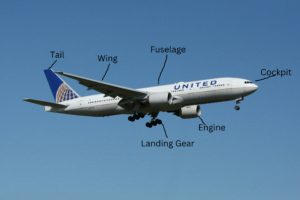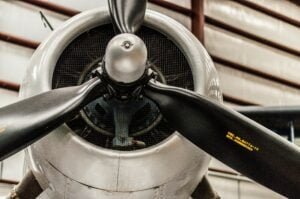Important Airplane parts and its functions.
Have you ever sat on a plane and wondered how a piece of metal could take us from Tonga to New Zealand and back?
Or watch it take-off and land thinking how.
While it might seem like magic, airplanes are meticulously designed machines, each part serving a crucial function in ensuring safe and efficient flight.
Let’s take a closer look at the various parts that make this engineering feat:

Fuselage:
The fuselage is the main body of the airplane, akin to its backbone. This main body is where everything important happens – the pilots command from the cockpit, passengers relax (or maybe cheer), and cargo stored away.
The fuselage provides structural support connecting the wings, tail and landing gear. Also, aerodynamic efficiency its streamlined shape reduces drag, allowing the airplane to move through the air with minimal resistance.
Cockpit:
Located in the Fuselage often referred to as the nerve center of the aircraft, the cockpit is where the pilots sit and control the airplane. It is equipped with an array of instruments, controls, and navigation systems essential for flying the aircraft safely.
Pilots use the cockpit to monitor vital parameters such as airspeed, altitude, engine performance, and navigation information. The cockpit is also where critical decisions are made during take-off, flight, and landing. Airlines call this part of their planes the flight deck.
Learn more here about the cockpit parts.
Wings:
The wings are perhaps the most iconic feature of an airplane. They generate lift, the force that enables the aircraft to overcome gravity and stay airborne.
Wings come in various shapes and configurations, each designed to optimize lift, stability, and manoeuvrability. Helicopters have rotary wings while most commercial airplanes have Swept Wings.
Here are some more examples.
The curvature of the wings, known as the airfoil, creates a pressure difference between the upper and lower surfaces, resulting in upward lift. This is known as Bernoulli’s principle.
Additionally, wings often house fuel tanks, providing the airplane with the necessary fuel for long-distance flights.
Engine(s):
The engine is the powerhouse of the airplane, responsible for generating thrust to propel the aircraft forward. Most modern airplanes are powered by jet engines or turboprop engines.
Jet Engines act like supercharged air compressors. They suck in air, squeeze it tight, then mix it with fuel and ignite the mixture. This fiery explosion creates a super-hot, high-speed jet of gas blasting out the back. Remember Newton’s third law? That whoosh of air pushes the airplane forward with incredible force!
Turboprop Engines: Imagine a jet engine working with a classic airplane propeller. They use a similar hot gas principle from the jet engine, but instead of just relying on exhaust thrust, they channel some of that power to spin a super-efficient propeller. This combo makes turboprops perfect for shorter flights or operating from smaller airports.
Tail (Empennage):
The tail section of the airplane, also known as the empennage, plays a crucial role in stability and control. It consists of the horizontal stabilizer, vertical stabilizer, and control surfaces such as the elevators and rudder.
The horizontal stabilizer helps maintain the aircraft’s pitch stability, while the vertical stabilizer prevents yawing motions. The elevators control the aircraft’s pitch, while the rudder controls yaw, allowing the airplane to turn left or right.
Fun fact: Each plane is assigned a Tail number, much like a license plate for vehicles. Aircraft registration numbers, or tail numbers, are a group of characters used to identify a specific aircraft. It is required by the International Civil Aviation Organisation (ICAO) used to track an aircraft’s history and ownership for tax collection and for regulation compliance.
All Tongan registered aircrafts have a tail number that starts with A3.
Propeller:

In airplanes equipped with piston or turboprop engines, the propeller is the primary means of propulsion.
Angled blades are attached to a central hub, and as they spin, they push a massive amount of air backwards. This whoosh of air creates thrust, propelling the airplane forward. Very clever. The angle of the blades can even be adjusted on the fly to give the plane extra power for take-off or make it more efficient during cruising.
Landing Gear:
The landing gear is in the undercarriage of an aircraft. It consists of a set of wheels, struts, and associated mechanisms that support the airplane during landing, take-off, and taxiing on the ground.
It typically consists of main landing gear located beneath the wings and a nose gear under the fuselage. The landing gear absorbs the shock of landing, provides stability during ground operations, and allows the airplane to taxi on runways and taxiways.
Here is a more detailed information.
Every airplane is a marvel of engineering. Every part, from the sleek fuselage to the sturdy landing gear, work together to achieve a single purpose: safe and comfortable flight. So next time you see a plane overhead, take a moment to appreciate the incredible human feat of design and technology that makes flight possible.
Interested in a career in the aviation industry? Contact us for a spot at our School of Aviation.
